Choose your municipality
There are several municipalities connected with The Green Menu, check whether your municipality is participating or choose for the national page.
Choose you menu card
There are several different menu cards. Choose a buildingtype down below and instantly start with the sustainable options!

Relatively speaking, most energy is lost through the roofs in uninsulated historic buildings. For country estates, insulating roofs can generate savings of up to 20% on the energy bill. How you can insulate the roof depends on the roof pitch, the space available on the inside or outside, and the cultural-historical value.
Always call in a professional for the post-insulation of roofs, especially with monuments. This avoids the risk of damage to the wooden or steel construction due to condensation. If you do not use the space under your roof on a daily basis, it is less interesting to insulate it with roof insulation and the space can better serve as a buffer. In that case, consider insulating the attic floor.
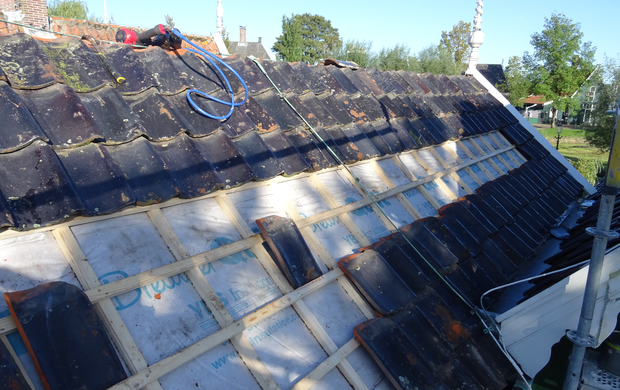
Most heat is lost through the roof, so insulating the roof reduces energy consumption considerably. A sloped roof is best insulated on the outside, because this limits the risk of moisture problems. Renovation of the roof is the best time to insulate, when the roof tiles have to be removed anyway. Always have the roof insulation carried out by a professional insulation company. Roof insulation on the outside is not always possible because the roof becomes 5 to 15 cm thicker after insulation. This should not conflict with the monumental view or the connection to the gutter line.
When insulating on the inside, the risk of moisture and wood rot in the construction is many times greater, which is why insulation on the outside is preferred for historic buildings.
Most heat is lost through the roof, so insulating the roof reduces energy consumption considerably. A sloped roof is best insulated on the outside, because this limits the risk of moisture problems. Renovation of the roof is the best time to insulate, when the roof tiles have to be removed anyway. Always have the roof insulation carried out by a professional insulation company. Roof insulation on the outside is not always possible because the roof becomes 5 to 15 cm thicker after insulation. This should not conflict with the monumental view or the connection to the gutter line.
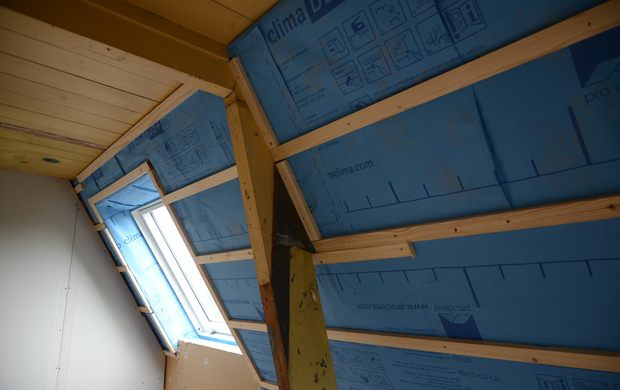
Roof insulation prevents unnecessary heat loss through the roof. The roof can be insulated on the inside between the beams of the roof. This is less effective than insulating on the outside, but is often easier to implement. And for historically valuable roofs, insulating on the inside has the advantage that it does not alter the appearance of the facade on the outside. Keep in mind, however, that about 5-15 cm of space is lost inside and that the wooden structure is usually no longer visible. Always have roof insulation applied by a professional company to prevent moisture problems.
A cold roof structure means that the insulation is applied underneath the construction. The structure and the roof finish are cold, as it were, as they are adjacent to the outside air.
Roof insulation prevents unnecessary heat loss through the roof. The roof can be insulated on the inside between the beams of the roof. This is less effective than insulating on the outside, but is often easier to implement. And for historically valuable roofs, insulating on the inside has the advantage that it does not alter the appearance of the facade on the outside. Keep in mind, however, that about 5-15 cm of space is lost inside and that the wooden structure is usually no longer visible. Always have roof insulation applied by a professional company to prevent moisture problems.
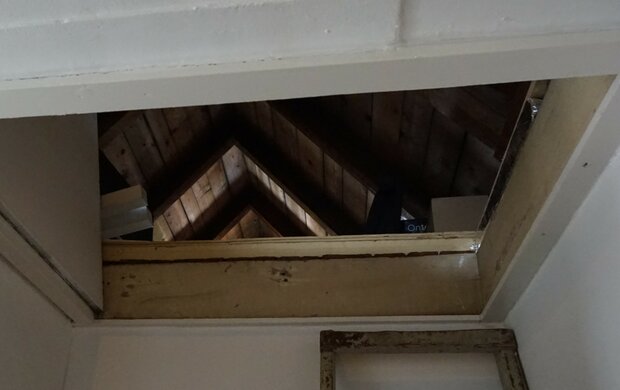
The attic is the upper part of a building, just below the roof. Warm air rises and is lost through the attic through the roof. Insulating the attic is interesting if the attic is not heated and is actually never used as a living space. The insulation material can be placed between the wooden floor beams or on top of the floor. Make sure that the access to the attic is also insulated. Insulating the attic floor is cheaper than roof insulation and yields the same reduction in heat loss.
If there is a desire in the future to use the attic in a different way, and the roof will then be insulated from the inside. Then you can opt for pressure-resistant wood fiber boards. These plates can then be reused to attach to the inside of the roof. A nice circular solution.
The attic is the upper part of a building, just below the roof. Warm air rises and is lost through the attic through the roof. Insulating the attic is interesting if the attic is not heated and is actually never used as a living space. The insulation material can be placed between the wooden floor beams or on top of the floor. Make sure that the access to the attic is also insulated. Insulating the attic floor is cheaper than roof insulation and yields the same reduction in heat loss.
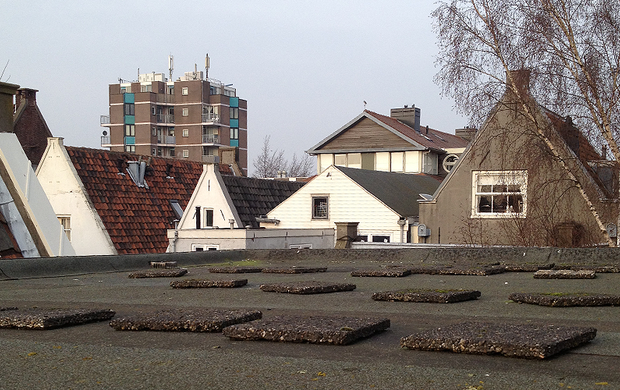
Flat roofs are best to insulate on the outside of the roof, which prevents heat loss and reduces energy consumption. By applying insulating material on top of the roof structure, you avoid the risk of moisture damage in the wooden structure. With interior insulation, this risk is greater for flat roofs. After insulation, the insulation panels are finished with a waterproof material. If your roof with roof covering is due for replacement soon, this is a good time to insulate on the outside. If the roof covering is still in good condition, you can also place waterproof insulation panels on top of the existing roof covering. With gravel or tiles, you prevent the insulation panels from blowing away, but this ‘inverted roof’ does not insulate as effectively.
Flat roofs are best to insulate on the outside of the roof, which prevents heat loss and reduces energy consumption. By applying insulating material on top of the roof structure, you avoid the risk of moisture damage in the wooden structure. With interior insulation, this risk is greater for flat roofs. After insulation, the insulation panels are finished with a waterproof material. If your roof with roof covering is due for replacement soon, this is a good time to insulate on the outside. If the roof covering is still in good condition, you can also place waterproof insulation panels on top of the existing roof covering. With gravel or tiles, you prevent the insulation panels from blowing away, but this ‘inverted roof’ does not insulate as effectively.
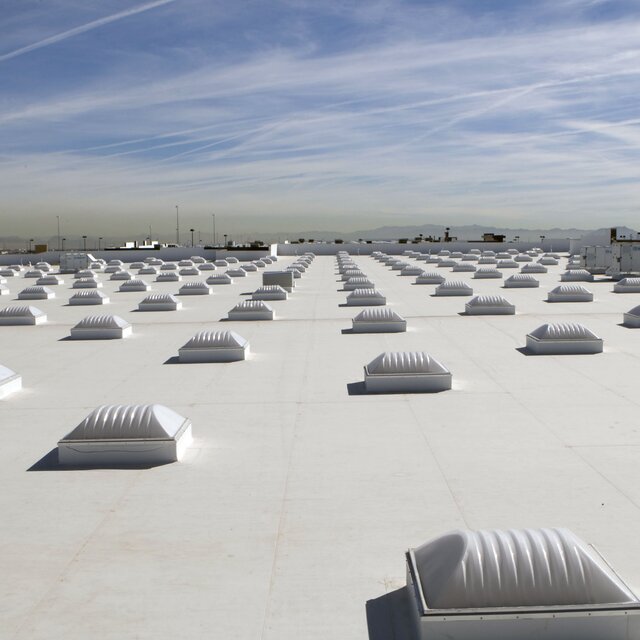
Black roofs absorb a lot of light and heat, which causes the roof and the spaces underneath to heat up. It also leads to heat stress in cities. This problem can easily be solved with white roof covering. The white colour reflects the sunlight and limits the heating of the building. Keep in mind, however, that this changes the appearance of the roof and makes pollution more visible.
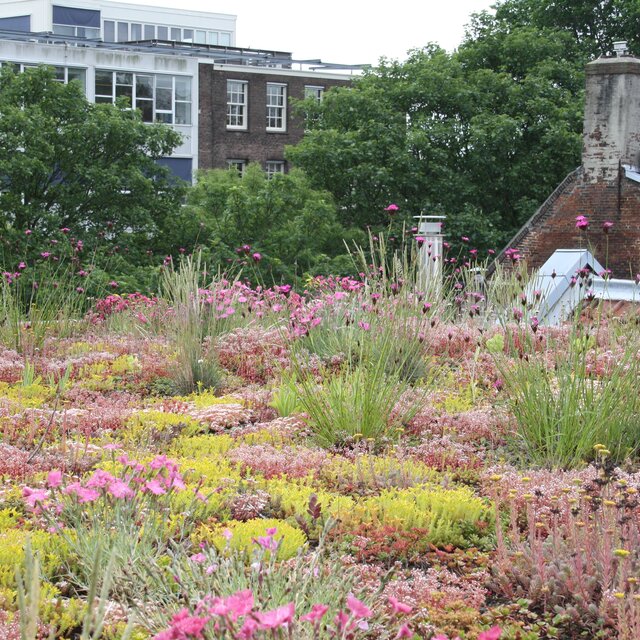
If you are replacing the roof covering, consider installing a green roof in addition to roof insulation. This can double the lifespan of the roof finish and keep the space underneath the roof cooler in summer. Moreover, your green roof will keep the city cooler and the streets drier during heavy showers.